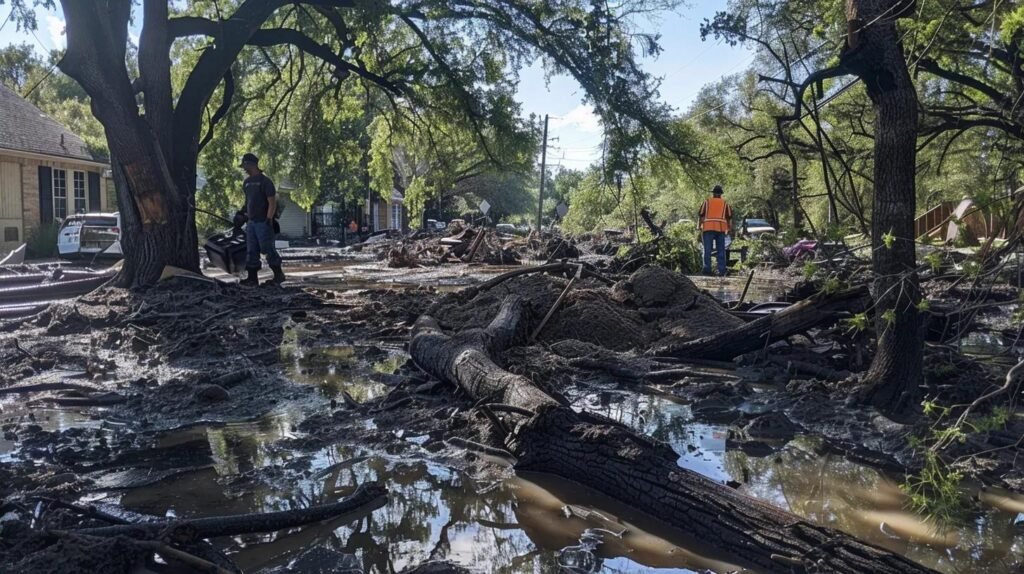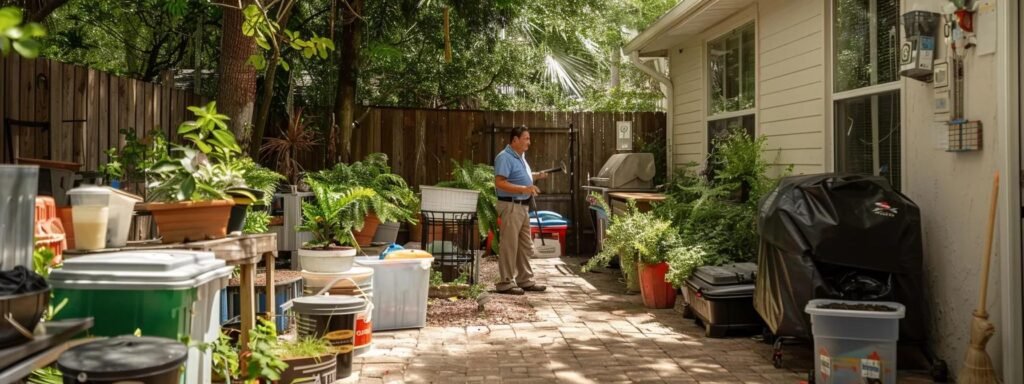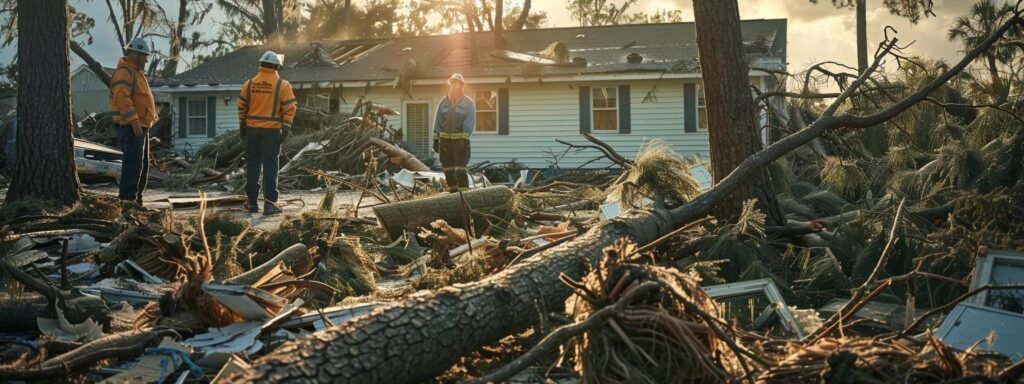

Ultimate Storm Preparation Checklist for Your Safety
Storms and severe weather pose significant threats to homeowners, risking property damage and loss of life. Preparing in advance can mitigate damage and ensure safety during natural disasters. In addition, contacting tree service debary can be crucial for addressing hazards like weakened trees or fallen branches before and after a storm. This checklist provides clear, step-by-step guidelines for storm preparedness, covering family emergency planning, home security, evacuation, and recovery. It is designed to help homeowners set up emergency kits, secure properties, evacuate efficiently, and manage post-storm recovery with expert, actionable advice.
What Are the Essential Steps in a Complete Storm Preparation Checklist?
Develop a structured plan covering prevention and response. Ensure every critical step is identified for emergencies through comprehensive planning.
How Do You Create a Family Emergency Plan for Storm Safety?
Designate roles, meeting points, and communication protocols. Establish a plan including emergency contacts, a safe room, and regular drills. Use a NOAA weather radio for timely alerts to maintain clear, coordinated communication during turbulent times.
What Emergency Supplies Should Be Included in Your Storm Kit?
Include non-perishable food, potable water, first aid supplies, flashlights, batteries, and a manual can opener. Add a portable NOAA weather radio, waterproofed important documents, cash, medications, and extra supplies for pets. Regularly check and replenish these items for continued functionality.
How Do You Secure Your Home Before a Storm Hits?
Trim dead trees, install storm shutters or impact-resistant windows, and reinforce roofs and doors. Secure loose outdoor items such as patio furniture and grills. Regular maintenance like cleaning gutters and checking for vulnerabilities helps minimize storm damage.
When and How Should You Evacuate During a Storm?
Evacuate based on official warnings and emergency management guidelines. Monitor real-time weather updates via NOAA weather radios, prepare evacuation routes ahead of time, pack a “go bag” with essentials, and communicate the plan to all family members.
What Are the Key Safety Tips to Follow During Different Storm Types?
For hurricanes, focus on securing property and reinforcing windows and doors; for tornadoes, seek shelter in the lowest, most interior part of a building; and for floods, evacuate immediately and avoid driving through water. Always unplug electrical devices when safe and stay informed via local news and official alerts.
How Do You Prepare Specifically for Hurricanes?

Hurricanes require specialized preparation due to their intensity and prolonged impact. Familiarize yourself with hurricane-specific protocols and supplies to protect your family and property.
What Is the Complete Hurricane Preparedness Checklist?
Before a hurricane, ensure your emergency supplies are fully stocked and your property is secured. Review evacuation routes and make pet care arrangements. After the storm, inspect for structural damage and document losses for insurance claims.
Which Supplies Are Critical in a Hurricane Supply Kit?
Assemble a kit with portable power sources, a first aid kit, bottled water, non-perishable food, and any emergency medications. Include waterproof storage for important documents, a battery-operated NOAA weather radio, cash, and multi-tools. Also add protective gear like sturdy shoes and gloves for cleanup.
How Do You Plan and Navigate Hurricane Evacuation Routes?
Research and identify multiple evacuation routes, considering both highways and local streets. Verify routes with recent traffic and weather updates, and mark alternative routes on a map or GPS device. Keep emergency contact numbers for local shelters handy and practice the routes with family.
What Hurricane Safety Tips Protect Your Family and Property?
Reinforce your home and conduct family evacuation drills. Stay indoors during the storm, avoid floodwaters, and designate a safe interior room away from windows to minimize exposure to storm debris while remaining alert to updates.
Where Can You Find Official FEMA Guidelines for Hurricane Preparation?
Access FEMA’s official website or local government emergency management offices for authoritative hurricane preparedness guidelines. These resources include detailed checklists and evacuation protocols to ensure your preparations meet national safety standards.
What Are the Best Practices for Tornado Preparation and Safety?
Tornadoes are unpredictable and require rapid response. A proactive approach and clear safety protocols can minimize injury and property damage during these violent storms.
How Do You Develop a Tornado Safety Plan for Your Home?
Designate a safe shelter, such as a basement or an interior room without windows, and practice tornado drills regularly. Establish communication plans including NOAA weather radio alerts, and review the plan annually to accommodate any household changes.
What Should a Tornado Emergency Kit Contain?
Prepare a kit with a well-stocked first aid kit, sufficient water, non-perishable food, and a battery-operated NOAA weather radio. Add flashlights, extra batteries, blankets, a whistle, and copies of key documents along with a multi-tool. Keep the kit in an easily accessible location.
How Does the Tornado Warning System Work and How Should You Respond?
Tornado warnings are issued via sirens, mobile alerts, and local broadcasts. Upon receiving a warning, immediately proceed to your designated safe shelter without attempting to observe the storm, ensuring prompt and calm action.
Where Is the Safest Place to Shelter During a Tornado?
The safest location is an interior room at the lowest building level, such as a basement or a small room without windows. Cover yourself with thick mattresses or blankets to further reduce injury risk until the all-clear signal is given.
What Are the Most Important Tornado Safety Tips for Families?
Regularly rehearse evacuation drills and maintain updated emergency kits and alerts. Ensure every family member knows the safety plan and the importance of immediate action. Secure heavy furniture and discuss safe shelter locations and emergency contacts.
How Can You Effectively Prepare for Floods and Minimize Damage?

Floods are common and destructive; proactive measures are essential to minimize water damage and ensure timely evacuation.
What Are the Essential Flood Safety Measures to Implement?
Install sump pumps, seal basement walls, and elevate electrical appliances. Use barriers or sandbags to prevent water from entering your home, and store critical documents in waterproof, elevated containers. Regular inspections and drainage maintenance are key.
How Do You Create a Flood Evacuation Plan?
Develop a plan that outlines primary and secondary evacuation routes, meeting points, and nearby shelters. Ensure the plan addresses the needs of all family members, including the elderly and pets, and rehearse it frequently.
What Items Should Be Included in a Flood Emergency Kit?
Assemble a kit with ample water, non-perishable food, a first aid kit, a battery-powered radio, and protective items like gloves and masks. Include waterproof storage for documents, extra clothing, and flashlights, as well as portable chargers and cash.
How Does Flood Insurance Work and Why Is It Important?
Flood insurance covers damage typically not included in standard homeowner policies. Understanding your policy terms, deductibles, and coverage limits is essential to offset repair costs and ensure rapid recovery. Review insurance options annually to adjust for risk changes.
Where Can You Access Local Flood Alerts and Resources?
Stay informed with flood alerts from community emergency management centers, local news, and official websites. Subscribe to mobile notifications from FEMA and regional weather stations to receive real-time updates.
What Are the Key Components of an Emergency Kit for All Storm Types?
An emergency kit is vital and must be versatile to meet various hazards. It ensures that basic survival needs are available regardless of the disaster type.
How Much Water and Food Should You Store for Storm Preparedness?
Store a minimum of one gallon of water per person per day for at least three days and a three-day supply of non-perishable food items. Adjust quantities based on family size and dietary needs, and rotate supplies to maintain freshness.
What First Aid Supplies Are Necessary in an Emergency Kit?
Include adhesive bandages, antiseptic wipes, gauze pads, and medical tape, as well as pain relievers, allergy medications, and any prescription drugs. A first aid manual and personal hygiene items enhance the kit’s overall effectiveness during emergencies.
Which Communication Devices Are Vital During Storms?
Ensure you have battery-operated NOAA weather radios, charged cell phones, and portable chargers. Consider satellite phones or two-way radios as backups if traditional networks fail, and maintain a waterproof list of emergency contacts.
How Do You Ensure Shelter and Warmth in Your Emergency Kit?
Pack insulated blankets, sleeping bags, and portable heaters along with extra clothing and waterproof tarps. Include a tent if evacuation shelters are not available to create a temporary, secure refuge.
What Are the Recommended Pet Emergency Supplies?
Your pet emergency kit should have food, water, medications, a leash, and a carrier. Also include items like bedding and favorite toys to reduce anxiety, along with a pet first aid kit and vaccination records.
How Do You Plan a Safe and Efficient Evacuation During Storm Emergencies?

Evacuation planning is critical to ensure that all family members exit safely when conditions worsen.
What Are the Steps to Identify and Use Evacuation Routes?
Research reliable evacuation routes provided by local authorities, and map both primary and secondary routes. Regularly update these routes and practice drills using printed maps or digital navigation apps to ensure a quick exit.
How Do You Prepare Emergency Contacts and Important Documents?
Compile a list of emergency contacts along with essential documents like insurance policies, identification, and medical records, securing them in a waterproof binder or bag. Digital backups stored in a secure cloud also help preserve important information.
What Is a Pet Evacuation Plan and How Do You Implement It?
Identify pet-friendly shelters and pack a dedicated “go bag” for your pet, including supplies and identification. Practice the evacuation process with your pet to ensure a smooth transition during emergencies.
What Should Be Included in a Comprehensive Evacuation Checklist?
An effective checklist should include emergency kits, pre-planned routes, personal identification, and necessary documents, as well as arrangements for pet needs and medical requirements. Ensure every family member understands the procedure and knows the meeting location.
How Can You Stay Informed During Evacuation?
Keep battery-powered radios, charged cell phones, and monitor local broadcasts. Follow local alert systems and emergency management social media for real-time updates on routes, shelters, and safety recommendations.
What Home Safety Measures Can Protect Your Property Before and After Storms?
Protect your property by reducing structural vulnerabilities and speeding up recovery post-storm.
How Do You Conduct a Home Inspection for Storm Readiness?
Inspect the roof, windows, doors, and foundation for weaknesses such as loose shingles or water damage. Professional inspections can help identify critical repairs that might be overlooked during regular maintenance.
What Home Protection Techniques Reduce Storm Damage?
Install storm shutters, reinforce garage doors, and use impact-resistant windows. Landscaping adjustments and water-resistant sealants further protect your home, while regular drainage system checks help prevent water damage.
How Should You Maintain Your Home to Prevent Storm Hazards?
Regularly clean gutters, inspect roofs, and address maintenance issues promptly. Maintaining nearby trees and shrubs can reduce the risk of falling branches during severe weather.
What Is Included in a Home Safety Checklist for Storm Preparedness?
Create a checklist covering structural inspections, securing loose items, and backing up essential documents. Include a maintenance log and emergency service contacts to ensure quick action before and after a storm.
How Do You Manage Post-Storm Home Repairs and Insurance Claims?
Document damages with photographs, keep receipts, and contact your insurance provider promptly. Work with licensed professionals to ensure repairs comply with local safety codes and minimize further risks.
How Can You Prepare Your Pets for Storm Safety and Emergencies?

Include your pets in all storm preparedness plans to ensure their safety during emergencies.
What Should Be in a Pet Emergency Kit?
Pack pet food, water, medications, a carrier, and essential hygiene supplies. Include familiar items like a favorite toy or blanket to help reduce stress during an emergency.
How Do You Create a Pet Evacuation Plan?
Identify pet-friendly shelters and pack a dedicated “go bag” for your pet with necessary supplies and identification. Practice the evacuation process to ensure a smooth transition during actual emergencies.
What Are the Best Pet Safety Tips During Storms?
Keep pets indoors in a secure, quiet room away from windows. Provide comfort items and maintain a calm environment, consulting your veterinarian for any additional advice if needed.
How Do You Manage Pet Health Before, During, and After Storms?
Schedule regular veterinary check-ups and keep current medications available. Monitor your pet after a storm for any behavioral changes or injuries, and seek prompt veterinary care when necessary.
What Are the Best Practices for Business Storm Preparedness and Continuity?
Businesses should prioritize storm preparedness to protect employees and ensure operations continue smoothly during and after a storm.
How Do You Develop a Business Continuity Plan for Storms?
Identify critical operations and create backup systems for data and communications. Outline emergency procedures, designate key personnel, and plan for alternative work locations.
What Should Be Included in a Business Emergency Kit?
Ensure the kit has critical IT equipment, backup power sources, first aid supplies, and essential documents. Include non-perishable food and water, as well as personal protective equipment to support employees during prolonged disruptions.
What Are Key Business Safety Tips During Storm Events?
Secure office buildings, back up data regularly, and review exit routes. Use mass notification systems and stay in contact with local emergency management to adapt quickly to changing conditions.
How Does Business Insurance Support Storm Recovery?
Review your business insurance policy to understand coverage for property damage, lost income, and extra recovery expenses. Consult with professionals to file claims promptly and reduce financial strain during recovery.
How Do You Recover Safely and Effectively After a Storm?

Post-storm recovery requires careful planning and strict safety protocols to restore homes and businesses without further risk.
What Are the Steps to File Insurance Claims After Storm Damage?
Document all damage with photos, compile repair estimates, and contact your insurance provider immediately. Maintain detailed records of communications and expenses for a smooth claims process.
How Do You Safely Conduct Home Repairs Post-Storm?
Begin with a comprehensive property inspection to identify hazards, and then engage licensed professionals for structural and electrical repairs. Secure necessary permits and ensure compliance with local safety codes.
What Mental Health Resources Are Available After Storm Trauma?
Access counseling services and community support groups to manage post-storm stress. Local health agencies and non-profit organizations may offer free or subsidized mental health services to help communities recover.
How Can Community Support Aid in Post-Storm Recovery?
Leverage local volunteer networks and municipal resources for cleanup and repair services. Participating in community recovery meetings can provide both practical and emotional support during the healing process.
Frequently Asked Questions
Q: How often should I update my storm emergency kit? A: Check and update your kit at least twice a year to keep supplies current.
Q: When should I evacuate if a storm warning is issued? A: Evacuate immediately upon receiving official warnings and instructions from local authorities.
Q: What is the importance of having a NOAA weather radio during storms? A: NOAA weather radios supply continuous, reliable updates and emergency alerts crucial for timely decision-making.
Q: How can businesses ensure minimal disruption during storm events? A: Develop and maintain a comprehensive continuity plan and keep updated emergency kits to reduce downtime.
Q: Why is pet-specific preparation crucial during storms? A: Including pets in your emergency plan minimizes stress and ensures their safety by relying on familiar routines and supplies.
Final Thoughts
Preparing for severe weather is essential for safeguarding your family, home, and business. By following these checklists and establishing comprehensive emergency plans, you can significantly reduce risks and ensure safety during storms. Stay informed, be prepared, and protect your loved ones when facing unpredictable storm events.